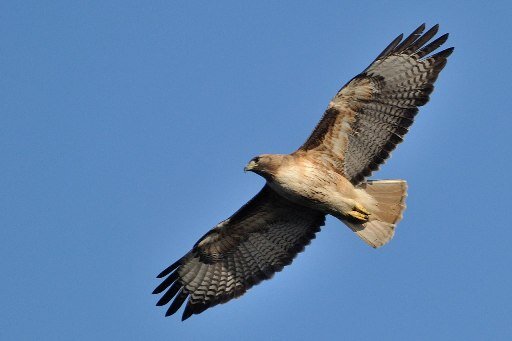Red-tailed Hawk
Buteo jamaicensis (Gmelin, JF, 1788)
Photo © By Don DeBoldCamera location37° 26′ 02.85″ N, 122° 05′ 15.14″ WView this and other nearby images on: OpenStreetMap - originally posted to Flickr as Hawk at Shoreline Park, CC BY-SA 2.0, https://commons.wikimedia.org/w/index.php?curid=6646067
STATUS
North America and middle America. Polytypic.
OVERVIEW
Species not admitted nationally (BOU 1971).
NOT PROVEN
0). 1850 Nottinghamshire Between Mansfield and Newstead, shot, autumn.
(Felkin, 1866; Whitaker, 1907).
[Eds., Ibis 1907: 648; BOU, 1915; W. B. Alexander & R. S. R. Fitter, British Birds 48: 5; BOURC (1974), Ibis 116: 579].
History Felkin (1866: 46) says: 'In the autumn of 1850, a Buzzard was brought to me, in the flesh, shot between Mansfield and Newstead; evidently from its superior size a different species to the Common Buzzard. John Gould, Esq., F.R.S., has kindly identified it for me as the Buteo borealis of American authors. Its occurrence in this country is remarkable.'
Whitaker (1907: 161) adds: 'Mr. Felkin, of Lenton, near Nottingham, stated in a list of birds he drew up in 1866, which he read at the British Association meeting held that year in Nottingham, that a Buzzard was brought to him in the flesh which had been shot between Mansfield and Newstead in the autumn of 1850. He submitted it to the late John Gould, F.R.S., who identified it as Buteo borealis. So far it is not only the only county but the only British specimen.'
In an Editorial (1907) in The Ibis, Vol. XLIX. p. 648, in a review of Whitaker's Birds of Nottinghamshire, they say: '...but we certainly do not, as yet, feel inclined to admit the Red-tailed Buzzard to the British List.'
W. B. Alexander & R. S. R. Fitter (1955) in British Birds, Vol. XLVIII. p. 5, say: 'An old record, at which both the BOU Committees looked askance, and which, as Coward said, cannot now be proved. There is some southward movement of this bird in eastern N. America in autumn.'
Absence of a specimen or a more precise date make this record unacceptable (BOURC (1974) Ibis 116: 579).
0). 1919 Orkney Kirkwall, Mainland, obtained, 16th March, now at Natural History Museum, Tring (BMNH 1939.12.9.3588).
(BOURC (1998), Ibis 140: 183).
[BOURC (1998), Ibis 140: 183].
History The specimen is in the Natural History Museum, Tring (BMNH 1939.12.9.3588) and said to have been obtained in Kirkwall, Orkney, on 16 March 1919. The identification is accepted, but the stated origin must be doubtful, given the specimen's provenance from the collection of Sir Vauncey Harpur Crewe (BOURC (1998) Ibis 140: 183).
